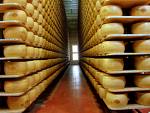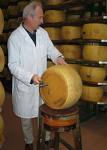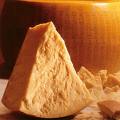|
Parmigiano Reggiano
By Lucio de Luca
Parmigiano-Reggiano, a hand-made product for 7 centuries, still greets this world unscarred by the impersonal brutalities of metal.
The prized milk of the “zona tipica”, treated with rennet and heat, is naturally matured and aged for two years or more.
The cheeses are carefully turned and, cared for, and watched, a process not without risks and anxieties, because the miracle of a perfect ripening is left essentially to nature.
A fundamental distinction.
It is at this stage that the real difference between Parmigiano-Reggiano and other cheeses appears.
The imitations, so often lumped together under the generic term “parmesan” are industrial mass products turned out in vast mechanized plants using technical processes which cut production at the expense of the “heart” and flavour which only the artisan’s respectful handling and nature’s patient maturing can guarantee.
A first class raw material calls for first class methods. The milk of the “zona tipica” is a regional speciality to the genesis of which soil, climate, fodder vegetation, cattle-rearing traditions, and other environmental factors less easy to categorize, have contributed with especially happy results.
A masterpiece of cheese making can be realized only through the operation of small, rural cheese dairies, where the farmers can deliver their product straight after milking and in a homogeneous condition.
The producers of Parmigiano-Reggiano are reconciled to the fact that this means that economic consideration must be sacrificed to the excellence of the product.
The milk is of course subjected to modern hygienic control but the role of science goes no further. Tested but untouched, the milk is used with its natural flora intact. No foreign bodies (i.e. anti-fermentative, etc.) are added. Parmigiano-Reggiano is a “whole food” of a flavour that is unmistakeably “old world”.
The production area of the Parmigiano-Reggiano.
The answer to the question, “how is Parmigiano-Reggiano made” begins which “where “ because the product is circumscribed by precise territorial limits.
Production is restricted to the “zona tipica”, which includes the provinces of Parma, Reggio Emilia and Modena in their entirety; the portion of the province of Mantua on the right bank of the river Po; the province Bologna on the left bank of the river Reno.
The work is done in a cheese dairy or “casello”. This is as a rule a small building, where on the overage, about eight cheeses are turned out daily. Although traditional methods are used, the organization and equipment are completely up to date and in line with the highest standards of modern hygiene.
With milk, rennet and fire.
The milk arrives from the neighbouring farms in a constant flow. Its exceptional qualities derive both from environmental factors and from the special milking habits of the heifers, which are reared with great care and nourished predominantly with fresh fodder.
Two successive milking are used in each batch of cheese: the evening’s milk is poured out into small trays to rest throughout the night; the morning’s milk is used after it has rested for approximately one our.
A portion pf the naturally accumulated cream is skimmed off; the evening and morning milks are then poured together into a copper cauldron shaped like and inverted church bell.
At this stage, the “starter” of fermenting whey is added. This whey is a residue of the preceding batch in which the lactic flora has developed by fermentation.
The practice, which is very ancient, raises the acid content of the milk to bring about the correct degree of fermentation in the cheese.
For this purpose the milk is heated in the cauldron to a temperature of 33degree Celsius (91 Fahrenheit), while stirring slowly.
The heat is then turned off and the rennet – a natural extract from the stomachs of sucking calves- is added to the milk.
Coagulation occurs within 12 to 15 minutes. In the coagulated milk or curd “cagliata” the most nutritive elements are solidified by the action or the rennet: the leftover liquid is known as whey.
The curd is turned over and broken up with a sharp-edged tool known as the “spino” (thorn-bush).
This operation reduces the coagulated mass to fragments the size of wheat grains, ready for the “cooking”.
Over a slow heat the temperature of the curd is raised to 45 degree Celsius (112 Fahrenheit); then the heat is stepped up sharply until the mass reaches a temperature of 55 degree Celsius (131 Fahrenheit).
When the heat is turned off, the cheese granules are precipitated towards the bottom of the cauldron where they again form a solid mass. After about half an hour this mass is raised with a wooden paddle, collected in a hemp sieve-cloth and then taken out.
It’s a long journey from Parmigiano-Reggiano milk to Parmigiano-Reggiano cheese.
Still wrapped in this cheesecloth, the “cooked” curd-mass is placed inside a circular wooden mould or “fascera” and lightly pressed down to ease out the remaining whey.
After a few hours the cloth is removed and a special stencil is inserted between the cheese and the inside of the mould.
The stencil impresses over the entire side of the new cheese the words “Parmigiano-Reggiano” repeated at close intervals. The cheese is turned at frequent intervals, to rest on each of its flat ends alternately, and is left in the mould for a few days, until its final shape is set without danger of subsequent distortion.
This characteristic form is a very squat cylinder with slightly bulging sides almost barrel shaped. The cheese is then removed from the mould and salted by immersion in coarse-salt brine for a period of 20-25 days.
After a brief exposure to the sun, the cheese is taken into the “cascina” – the storehouse where the first stage of maturing takes place. There the cheese is placed on massive wooden shelves where it is regularly brushed clean and turned over. The total production of any cheese dairy for one season, or cheese making year, is know as “la partite” – the crop of the year, or the “lot”.
From then onward, Parmigiano-Reggiano undergoes a long process of maturing, afterwards continued in adjoining store rooms to which the whole season’s production is usually transferred at the end of the year.
The rooms used for maturing Parmigiano-Reggiano are spacious premises, made to accommodate 50 to 100 thousand chesses and designed to favour slow, even aging.
Generally speaking, the maturing installation is managed by banking houses or co-operative organisation.
These ensure that the cheeses in their care receive all the specialized attention they require and employ highly qualified personnel for that purpose. In addition to this, they provide financial assistance for the dairies storing the cheese.
Two gallons of milk for every pound of cheese.
Every Parmigiano-Reggiano cheese is a miniature storehouse of concentrated nutrients. One pound of it represents 2 gallons of special quality milk, exceptionally rich in proteins, fat, calcium and phosphorus, from some of the world’s most favourably endowed pastureland.
This high-powered body-builder is a readily digestible food, owing to the fact that its composition includes substances that help the system to assimilate gently and efficiently the nutrients it contains.
The cheese matures by a totally natural and spontaneous process.
No additives or artificial manipulation of temperature are employed. This is one of the secrets of Parmigiano reggiano’s three vital characteristics: conservation of an extremely high food potential, inimitable flavour, and easy digestibility. Extensive research has been conduced to determinate the nutritive content of Parmigiano Reggiano.
Protein accounts for 33%, a higher figure than that of any other type of cheese. The butterfat content is also substantial, although not excessive (28%), and the calcium content is extremely high (1,16%) as is that of phosphorus (0,70%).
Parmigiano-Reggiano also has a well-balanced range of vitamins. The caloric value is 392 calories for 100 grams. In short, the Parmigiano-Reggiano has an extremely high content of body building proteins and high quality fats, plus an unusual concentration of vitamins and mineral salts.
Good for you and any age.
Biochemists and dieticians agree that Parmigiano Reggiano holds a privileged position among food products. It is recommended not only for a variety of culinary uses and as a table cheese, but also as an important component in prescribed diets designed to meet the special needs of sickness or old age. Italian paediatricians, for example, advise mothers and nurses to enrich baby foods with Parmigiano-Reggiano.
During the subsequent years of growth, the calcium, phosphorus and other minerals and vitamins of the cheese provide excellent nutrition for the growing body. Parmigiano-Reggiano should of course be included in any sensible adult diet as well. It is an ideal food because it includes a substantial number of food elements necessary for sustenance, because it nourishes without fattening and because it is easily assimilated.
The importance of the rind.
The rind or crust of Parmigiano-Reggiano is its natural protective casing, a peripheral hardening of the cheese, which begins the first formative days and comes to completion with its maturation.
It is about five millimetres thick. This is edible and should not be wasted. After external scraping to remove any impurities, it can be used in cooking or to flavour soups with excellent result. The rind bears the marking, which guarantee the authenticity of the product and certify its origin. Because these are imprinted continuously over the vertical “wall” of the cheese, they appear on each of the portions or wedges into which it is divided. Therefore, every piece of cheese sold should include the rind, not only because of the guarantee but also because it helps to keep the cheese fresh. Parmigiano-Reggiano should never be purchased already grated.
An honest food: natural, genuine and unique.
These are perhaps the terms, which have been used most freely in our efforts to do justice to Parmigiano-Reggiano. Not empty words, but the accurate description of an honest food.
Unique.
This definition has been stressed at the outset, where we defined its meaning by shoving that no other cheese can point to such a venerable ancestry, with the record of enduring demand this implies.
The unique quality of Parmigiano-Reggiano consist in the methods by winch it is made: to the long, slow maturing, to the extraordinarily concentrated food value; to the old-word flavour and other remarkable traits which enable us to call Parmigiano-Reggiano the only cheese of its kind in the world.
Composition for 100 gr. Parmigiano-Reggiano cheese.
Moisture gr 30.8
Protein gr 33.0
Fat gr 28.4
Calcium gr 1.16
Phosphorus gr 0.68
Calcium/phosphorus ratio 1.71
Sodium chloride gr 1.39
Magnesium mgr 43
Zinc mgr 4
Vitamin A µgr 298
-“- B1 µgr 32
-“- B2 µgr 370
-“- B6 µgr 106
-“- B12 µgr 4.2
Choline mgr 42
Biotin µgr 22
The storing of Parmigiano-Reggiano
Parmigiano-Reggiano is the only cheese, which does not deteriorate rapidly, but, to preserve its fragrance, flavour and tenderness, it is important to know how to store it.
Sometime it can be purchased vacuum-packed in special film or foil. Such a package, if unopened and refrigerated, will preserve the cheese in peak condition for a long period.
© deluca.se, LdL International AB
|



|